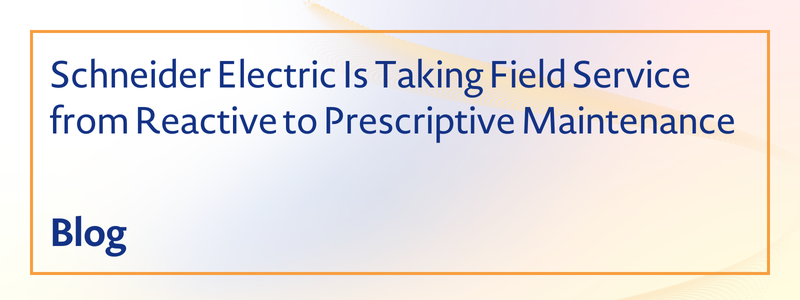Schneider Electric Is Taking Field Service from Reactive to Prescriptive Maintenance


Asset management is an ongoing concern for global industry, especially during these tough times. Businesses have enough to worry about right now without unplanned downtime adding to them.
Unplanned downtime is one of the largest causes of productivity losses in manufacturing, resulting in output delays and seriously unsatisfied customers. In fact, it's estimated that unplanned downtime costs industrial manufacturing companies an estimated $50 billion each year.
Maintenance is at the core of reducing the chances of unplanned downtime and the resultant loss in revenue. But, with so many different schools of thought on the subject, it's hard to know which way to turn. Thankfully, innovative brands such as Schneider Electric are already pushing forwards with incredibly forward-thinking ideas, as evidenced in a new white paper by the global energy and automation company.
Data-Driven Asset Performance Management
The old way of performing maintenance was, in hindsight, staggeringly inefficient. Issues would be reported as they materialized, and engineers would only then be dispatched to repair them. Of course, by this point, unplanned downtime had already occurred, and production would grind to a halt, causing the business concerned to immediately begin hemorrhaging revenue.
Needless to say, reactive maintenance has a high risk of unplanned downtime and creates a high-pressure environment when breakdowns inevitably occur, leading to production losses and a high lifecycle cost on the assets concerned.
Then we have preventative maintenance, where assets are maintained according to a schedule in an effort to improve performance and prevent major failures. This kind of scheduled maintenance can offer savings of 12-18% compared to reactive methods over the lifetime of the asset.
However, the creme-de-la-creme of maintenance philosophies is predictive and prescriptive service. With Internet of Things (IoT) sensors constantly reporting back on the condition and performance of assets - right down to the level of individual components - service can be provided based on the actual health of the equipment, rather than a fixed schedule. Not only does this method avoid unnecessary maintenance, but it also ensures asset optimization and can result in savings of 30-40% when compared to other methods.
Which this kind of field service provision, data is constantly analyzed by a combination of sophisticated AI software and expert human data scientists. If a component shows early signs of failure, an engineer can be immediately dispatched to repair or replace it - before a shutdown even occurs. Not only this, but the engineer can also arrive on site armed with all the information and parts he/she requires to complete the job - significantly increasing the rate of first-time fixes and boosting customer satisfaction as a result.
"The trend among asset-intensive companies to view maintenance as a potential area of profit rather than expenditure has driven investments in asset performance management solutions," writes Schneider Electric in the white paper. "The promise of predictive maintenance, which is more cost-effective than routine maintenance, and extends the life of assets, has popularized such solutions, especially with manufacturers burdened with ageing infrastructure."
Schneider Electric
Naturally, Schneider Electric is also offering an ever-increasing suite of solutions which aim to meet these needs for more proactive and prescriptive field service provision.
One of the more exciting technologies being offered by Schneider is the EcoStruxure Plant Augmented Reality Solution. This uses AR technology to make sure engineers always have access to all the digital field service manuals, schematics, and blueprints they need to carry out their roles. It also enables them to superimpose schematics directly onto infrastructure, making it far easier to locate and repair the elements which require their attention.
The AR technology can also connect to a central call center using screen sharing and voice activation, which can help lone engineers access other experts to assist them on those more complicated jobs where two heads are better than one.
"AR technology simplifies complex processes by placing the right information (manuals, documents, experts) in the right place at the right time," says Schneider Electric. "It bridges the gap between the cyber-physical IoT and the real world and creates a composite environment to engage operators in a dynamic and interactive way by offering step-by-step and intuitive task guidance."
Final Thoughts
It takes innovative brands like Schneider Electric to lead the way in these matters. With field service being a constantly evolving field, new and exciting technologies are being ever more interwoven to boost revenue - for field service providers and their clients - and significantly increase efficiencies and productivity.
Hear expert speakers talk on this and more at Field Service Palm Springs 2021, taking place in November at the JW Marriott, Palm Springs, CA.
Download the agenda today for more information and insights.